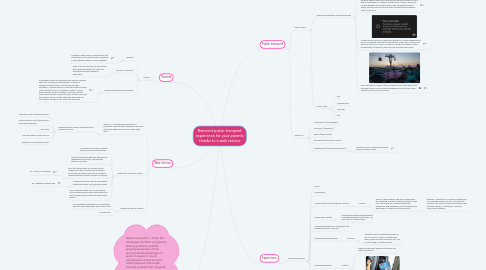
1. Parents
1.1. Can be :
1.1.1. Workers
1.1.1.1. Looking for web service offering them the possibility to travel next to their colleagues in long-distance travels to work together
1.1.2. Tourists on holidays
1.1.2.1. Want to be able to travel all around the world without getting lost thanks to worldwide transport guidance application
1.1.3. Adults looking after their children
1.1.3.1. SchoolBusNet and Followmykid are suites of software apps that manage and disseminate all details of student's transportation. It plans and monitors operations, enables parents to see the location of their child’s school bus on a smartphone, tablet, or even make changes to their schedule ! This way, parents know when the bus is near their stop, so they can send the children out at just the right time While they do not need to call the school every now and then.
2. Web Service
2.1. What is it ? A standardized medium to propagate communication between the client and server applications on the World Wide Web
2.1.1. Benefiting from modern technology and software such as :
2.1.1.1. Automatic fare collection systems
2.1.1.2. Data collection about users’ public transport experience
2.1.1.3. GPS data
2.1.1.4. User perception of the service
2.1.1.5. Reduction of operational costs
2.2. What can it provide to users ?
2.2.1. Information on public transport services, fares and timetables
2.2.2. Practical and comprehensive guidance on designing transit lanes, intersections, stations and stops
2.2.3. Real-time information on multiple transit modes accurately tracking and predicting arrival times at stops, terminals and stations, allowing travelers to plan journeys in advance
2.2.3.1. Ex : Moovit, CityMapper
2.2.4. It allows women to rate their perception of personal safety on the transit system
2.2.4.1. Ex : Bogotá’s Safetipin app
2.2.5. Geo-referenced data can be used by the city to design and prioritise interventions to improve the transit system and other public spaces
2.3. Marketing aspect/Support
2.3.1. On smartphone applications, to make their services more fashionable and easier to use
2.3.2. On web sites
3. Research question : Given the challenges of traffic congestion, parking problems and the growing awareness of the environmental advantages of public transport, how do metropolises intend to build intermodal and multimodal mobility systems that integrate new means of transport, while offering innovative payment and passenger information services available on web services to improve the customer experience ?
4. Public transport
4.1. Which ones ?
4.1.1. Innovations through connected devices
4.1.1.1. The Hyperloop proposed by SpaceX’s Elon Musk is capable of moving people at aircraft speeds for the price of a bus ticket (full system testing is scheduled for 2017 with a goal to start moving passengers in 2021)
4.1.1.2. Personal Rapid Transit (PRT) hold smaller groups of people in cars that are operated by computer using electric motors, and move on light weight tracks. Riders select their destination prior to riding, and each car only goes to their final destination without stops on the way.
4.1.1.3. Olli self driving mini-bus, rather than operate on a fixed schedule and route, is operated and paid through an app. Where ever you are, can become a bus stop. This bus is ideal for filling in the gaps in public transportation to take you that last mile from the metro stop
4.1.1.4. The Mexicable is a seven-stop line that runs just over three miles through a furrow of poor hillside neighborhoods to avoid traffic congestion and reduce pollution
4.1.2. Classic ones
4.1.2.1. Rail
4.1.2.2. Underground
4.1.2.3. Tramway
4.1.2.4. Bus
4.2. What for ?
4.2.1. Convenience (accessibility)
4.2.2. Efficiency (frequency)
4.2.3. Speed (rapid transit)
4.2.4. Affordability (economic reason)
4.2.5. Sustainability (environmental reason)
4.2.5.1. Improve local air pollution by shifting to zero emission buses
5. Experience
5.1. Failings/Successes
5.1.1. Delay
5.1.2. Cancelation
5.1.3. People getting lost during their journey
5.1.3.1. Solution
5.1.3.1.1. Ideally, a single agency should be responsible for managing all public transport systems in the city. This allows for seamless intermodal integration and timetabling, smart ticketing and single apps for users to find information
5.1.4. Queue time wasted
5.1.4.1. Integrated ticketing allowing people to change between modes (bus, rail, and ferry) on a single ticket
5.1.5. Time wasted waiting for transports (not reliable and timely services)
5.1.6. Uneasy payment methods
5.1.6.1. Solution
5.1.6.1.1. Integrated fares allowing passengers to pay only once for trips no matter how many modes of public transport (bus, rail, or ferry) used in a single journey
5.1.7. High boarding time
5.1.7.1. Solution
5.1.7.1.1. Prepaid smartcards loaded with money and other information
5.1.7.1.2. The ‘contactless’ debit card can be used just like a transport ticket like in Dijon
5.1.8. Areas not served by public transport
5.1.8.1. Solution
5.1.8.1.1. Autonomous electric shuttles by Keolis and Navya
5.1.9. Tickets sold out
5.1.9.1. Solution
5.1.9.1.1. App creating alerts when new tickets become available such as OUIBOT on Messenger for rail tickets
